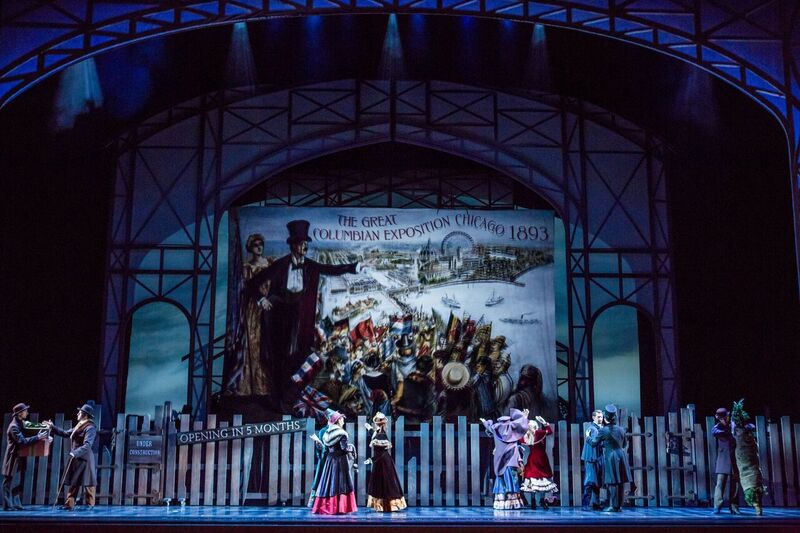
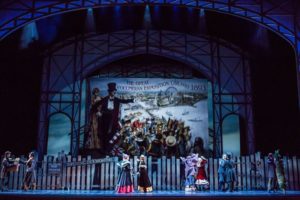 [rating=5] The Joffrey Ballet’s new production of The Nutcracker is a timely and deeply resonate story about the aspirations and history of Chicago. It was a risk the venerable company didn’t have to make: the production of Pyotr Tchaikovsky’s seasonal favorite designed by Robert Joffrey was a decades-old Chicago tradition. Like most ballet companies in the world, the Joffrey likely relied on the faithful old warhorse to bring in a substantial portion of its ticket sales for the entire season. But when Ashley Wheater became the Joffrey’s artistic director ten years ago, he know he wanted to do a Nutcracker which would be beloved because it would speak to people’s present concerns, instead of being something as reliable and eternal as the seasonal shifts. A decade later, he’s earned the credibility to make such an enormous change, and it has paid off. Under the choreography of Christopher Wheeldon, with an adapted story by Brian Selznick, the new Nutcracker shows the hopes of our immigrant ancestors who made this city great, and who declared at the 1893 World’s Columbian Exposition that Chicago was a home for people from around the world.
[rating=5] The Joffrey Ballet’s new production of The Nutcracker is a timely and deeply resonate story about the aspirations and history of Chicago. It was a risk the venerable company didn’t have to make: the production of Pyotr Tchaikovsky’s seasonal favorite designed by Robert Joffrey was a decades-old Chicago tradition. Like most ballet companies in the world, the Joffrey likely relied on the faithful old warhorse to bring in a substantial portion of its ticket sales for the entire season. But when Ashley Wheater became the Joffrey’s artistic director ten years ago, he know he wanted to do a Nutcracker which would be beloved because it would speak to people’s present concerns, instead of being something as reliable and eternal as the seasonal shifts. A decade later, he’s earned the credibility to make such an enormous change, and it has paid off. Under the choreography of Christopher Wheeldon, with an adapted story by Brian Selznick, the new Nutcracker shows the hopes of our immigrant ancestors who made this city great, and who declared at the 1893 World’s Columbian Exposition that Chicago was a home for people from around the world.
Traditionally, The Nutcracker is broken up into two halves, with the first half being a fantasy loosely adapted from a story by E.T.A. Hoffman, and the second half being an awkward pastiche of fake ethnic dances presented just for their own sake. Wheeldon’s vision integrates the two parts by making the series of short dances in Act II the show’s centerpiece. His version is set in December of 1892, when the original run of The Nutcracker was playing in St. Petersburg, but our story takes place at the still-under construction fairgrounds on Chicago’s south side. The first image we see is a massive poster proclaiming that new migrants are being brought in to finish the fairgrounds. Look closely, and you’ll notice it depicts an anachronistic mix of flags, including those of the Qing dynasty and the People’s Republic of China, and monarchial and republican Egypt.
Marie (Amanda Assucena at opening; as usual, there’s a rotating cast) and her little brother, Franz (Dylan Sengpiel), are not members of a comfortable upper-middle class family or the minor nobility in this version, but are the immigrant children of the widowed artist sculpting the Statue of the Republic. In an expertly staged bit of wordless storytelling, we see in the opening scenes that Marie likes a boy, Peter (Alberto Velazquez), who works for the Daniel Burnham-like Great Impresario (Miguel Angel Blanco). She worries about the mischievous Franz, who is being badly influenced by other boys who steal from the workers and is the object of a creepy rat catcher’s attention. Peter defends Franz like an older brother, and they go to the home of Maria’s mother (Victoria Jaiani) to attend a party being thrown for the fair’s employees, with the Great Impresario himself making an appearance.
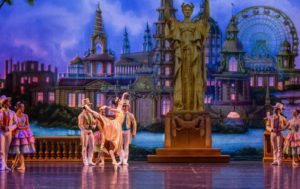 Joffrey music director Scott Speck leads the Chicago Philharmonic in a rendition of Tchaikovsky’s score which is lovely, as always, but the scenes of the party have been orchestrated for a small onstage band consisting of a cello, fiddle, and clarinet. This gives the dances a much folksier air to them, and the choreography combines old world and American traditions. The poor family’s Christmas tree is lousy, but the Great Impresario dazzles everyone with a vision of what the fair will look like when it opens. As Marie slips into her dream world, she sees the room being swarmed with rats, in what is one of the more unsettling images to grace the stage this holiday season, thanks to the puppetry of Basil Twist.
Joffrey music director Scott Speck leads the Chicago Philharmonic in a rendition of Tchaikovsky’s score which is lovely, as always, but the scenes of the party have been orchestrated for a small onstage band consisting of a cello, fiddle, and clarinet. This gives the dances a much folksier air to them, and the choreography combines old world and American traditions. The poor family’s Christmas tree is lousy, but the Great Impresario dazzles everyone with a vision of what the fair will look like when it opens. As Marie slips into her dream world, she sees the room being swarmed with rats, in what is one of the more unsettling images to grace the stage this holiday season, thanks to the puppetry of Basil Twist.
After Marie’s newly beloved nutcracker toy transforms into Peter as a dashing prince, the Impresario whisks them off to the fairgrounds. But first they pass through a Waltz of the Snowflakes which, thanks to Wheeldon’s energetic choreography and Julian Crouch’s crystalline costumes, is more like a Waltz of the Ice Splinters. Marie and Peter must really be enamored of each other to find this lake effect weather an adrenaline booster. It soon becomes clear that that is the case, for, while in traditional Nutcrackers Clara/Marie’s dreamscape fantasies center on candy and syrupy drinks, the ones on display here are more reflective of a teenaged girl’s desires. Christine Rocas and Fabrice Calmels are a very sensual pair of Arabian dancers—Marie and Peter’s sudden realization that their legs were touching while watching them drew some sympathetic chuckles from the audience. The rest of the world-ranging wonders of the fair are each delightful in their own way, as well (they include China, Italy, Spain, and our own Old West) but it’s their harmony which makes the Exposition such an uplifting experience. Marie’s mother appears as her own statue, and in a ballet full of graceful dancers, Jaiani’s Dance of the Sugar Plum Fairy is particularly exquisite.
The pas de deux between the Statue of the Republic and the Impresario is symbolic of a new family for our protagonists, the historical revival of our city, and the potential for creation which it still contains. Benjamin Pearcy’s projections and Natasha Katz’s 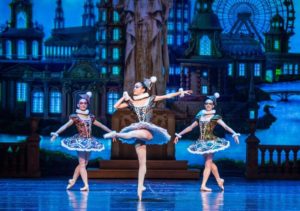 lighting do heavy duty providing the arresting visuals of Wheeldon’s Nutcracker, and the opening outward of the proscenium at the end is a clear invitation for us to take up the aspirations the fair represented. Those familiar with The Devil in the White City will know that when the Exposition actually opened, it became associated with some considerably darker events, and its celebration of Columbus’s voyages is no longer seen as compatible with humanism, but its overall point about Chicago being a city fueled by creative passion from around the world was still readily received by millions of people over a hundred years ago. One tradition which has been retained at the Joffrey is that, along with their top-quality company artists, an adorable company of children dance in the party scene and with Mother Ginger (who has been humorously re-imagined this year, as well). While honoring the previous version of the story, and certainly making full use of the drama in Tchaikovsky’s music, this new Nutcracker is specifically Chicagoan, and amid our current and coming struggles, is a hopeful and much-needed reminder this holiday season of what is best in ourselves and in our neighbors.
lighting do heavy duty providing the arresting visuals of Wheeldon’s Nutcracker, and the opening outward of the proscenium at the end is a clear invitation for us to take up the aspirations the fair represented. Those familiar with The Devil in the White City will know that when the Exposition actually opened, it became associated with some considerably darker events, and its celebration of Columbus’s voyages is no longer seen as compatible with humanism, but its overall point about Chicago being a city fueled by creative passion from around the world was still readily received by millions of people over a hundred years ago. One tradition which has been retained at the Joffrey is that, along with their top-quality company artists, an adorable company of children dance in the party scene and with Mother Ginger (who has been humorously re-imagined this year, as well). While honoring the previous version of the story, and certainly making full use of the drama in Tchaikovsky’s music, this new Nutcracker is specifically Chicagoan, and amid our current and coming struggles, is a hopeful and much-needed reminder this holiday season of what is best in ourselves and in our neighbors.
The Joffrey Ballet’s production of The Nutcracker will continue at The Auditorium Theatre, 50 E Congress Parkway, Chicago, thru December 30, playing at 2:00 pm and 7:00 pm on varying days.
Running time is two hours with one intermission.
Tickets are $35-170; to order, call 312-386-8905 or visit Joffrey.org. There are several nearby parking garages, and the Auditorium Theatre has a promotional deal with Loop Auto Parks at 524 S Wabash. There are more details on the Joffrey’s website.
To see what others are saying, visit www.theatreinchicago.com, go to Review Round-Up and click at “The Nutcracker.”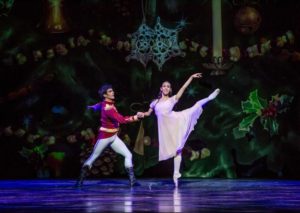

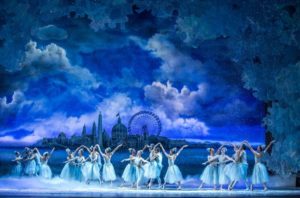





More Stories
“The Da Vinci Code”
“Titanic the Musical”
“Henry Johnson”